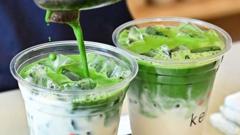The recent explosion of matcha's popularity has taken the world by storm, with this vibrant green tea becoming an essential ingredient in everything from lattes at Starbucks in the UK to specialty doughnuts at Krispy Kreme in Singapore. The rapid rise in demand can be largely attributed to social media, where influencers extensively share brewing tips, recipes, and enthusiastic reviews under the trending hashtag "Matcha Tok," which has garnered tens of millions of views.
The demand for matcha has received an additional boost from Japan's tourism resurgence post-COVID, as the country's favorable currency exchange rates make it an appealing destination, alongside heightened interest in Japanese products. However, this insatiable appetite for matcha has resulted in drastic shortages. Lauren Purvis, an importer from Mizuba Tea Co., reports that her clients are experiencing substantial delays in supply, with some cafés needing up to a kilogram daily just to meet their customers' expectations.
One major factor impacting matcha availability is the severe heatwaves affecting tea crops and labor shortages in Japan, where agriculture is increasingly hampered by an aging population. The Uji region, renowned for its matcha production, has recorded below-average yields, leading to retail shelves being stripped bare in minutes once the doors open. As a countermeasure, some shops, including Kyoto-based Camellia Tea Ceremony, now limit customers to a single tin of matcha, a move reflecting the escalating strain on the supply chain.
With delays in deliveries extending beyond a week, tea master Rie Takeda at Tokyo's Chazen tea ceremony venue has also witnessed a price hike of about 30% for matcha this year, underscoring the economic pressures influencing this beloved beverage. Nonetheless, the growing popularity has also piqued the interest of new growers, with Japan's agricultural ministry noting a threefold increase in matcha production since 2010 and a 25% increase in green tea exports last year.
The increasing demand has spurred advocates for more conscious consumption of matcha, discouraging the hoarding of the prized tea. Some experts emphasize that its delicate flavor might be best appreciated in its pure form rather than oversaturated in culinary uses, lamenting when premium matcha is employed in cooking where its taste may be compromised. To maintain respect for the craft, the Global Japanese Tea Association is encouraging consumers to utilize more abundant, lower-grade matcha for culinary purposes, safeguarding the high-quality tea’s distinct flavor.
Going forward, looming tariffs imposed by the US on Japanese imports threaten to exacerbate the situation. Tea distributors like Purvis are preparing for a potential surge in matcha prices, with fears that the specialty tea industry could be negatively impacted by the latest trade agreements. Despite current challenges, industry insiders remain hopeful that the intense demand for matcha will temper, predicting a normalization within the next two to three years.





















